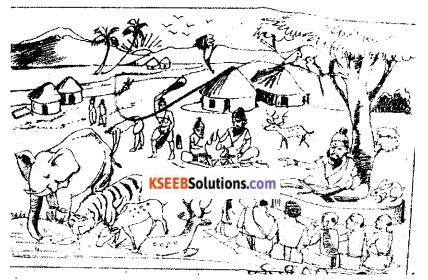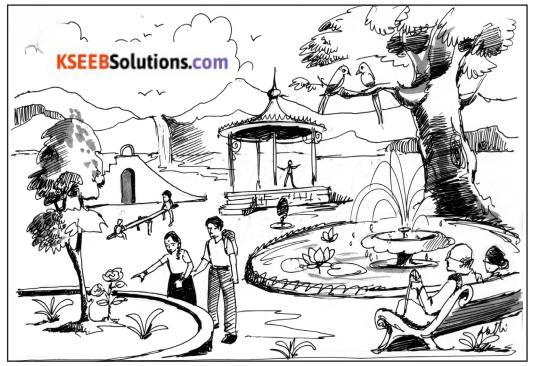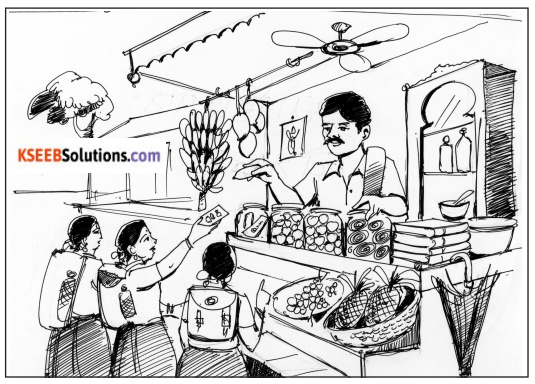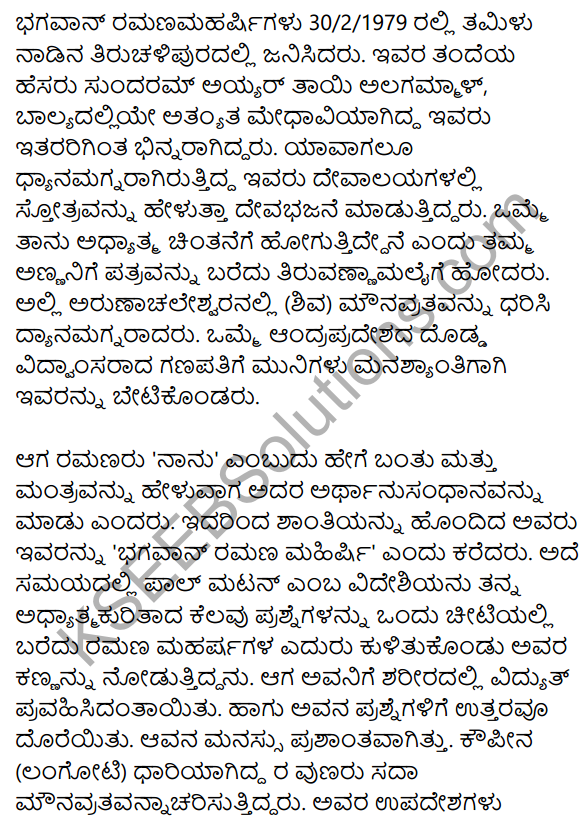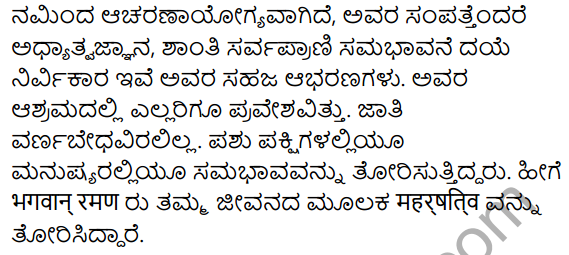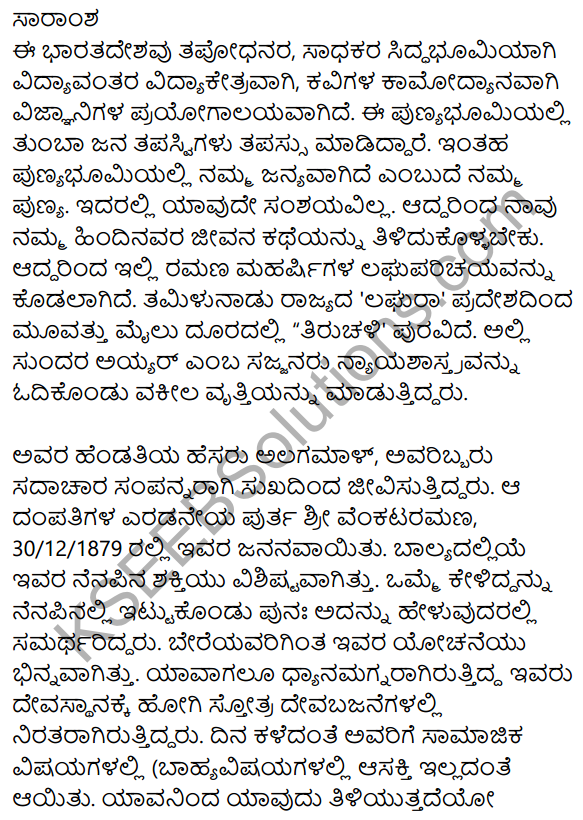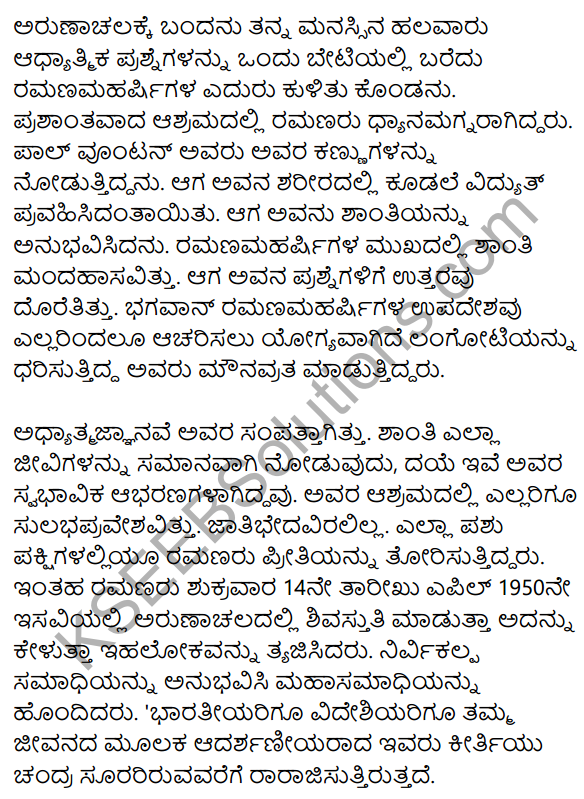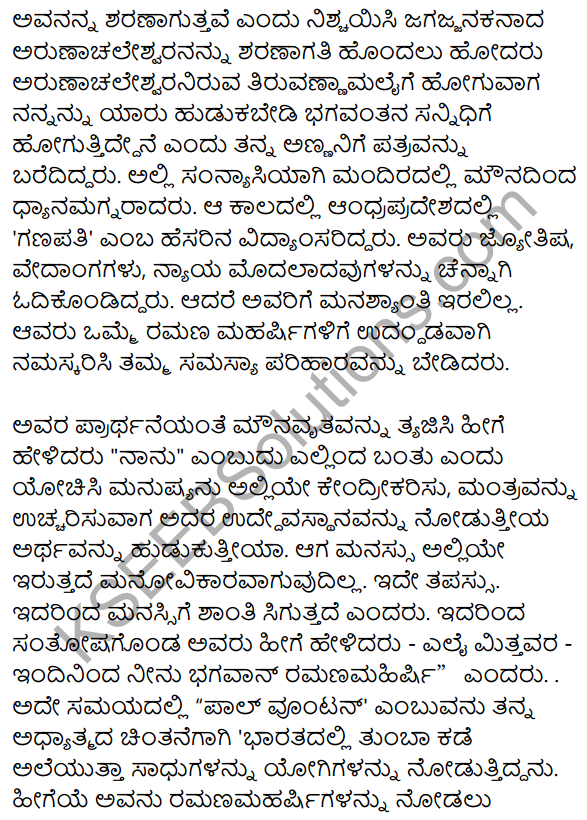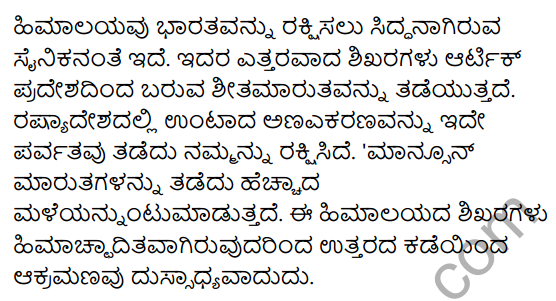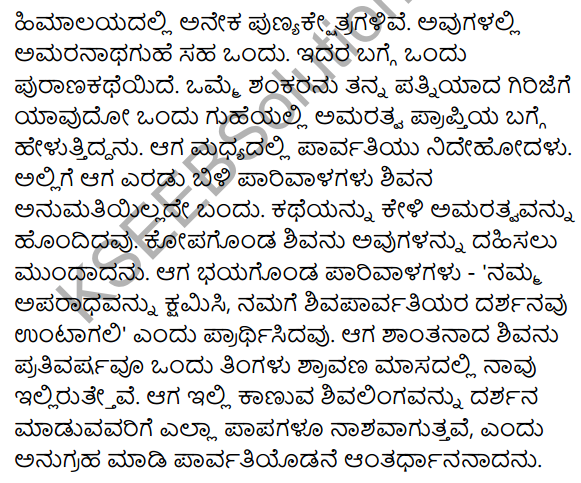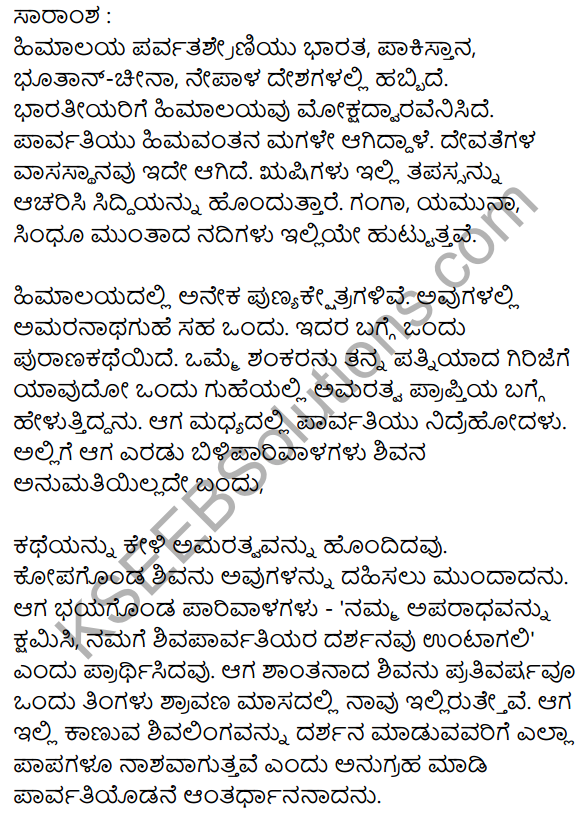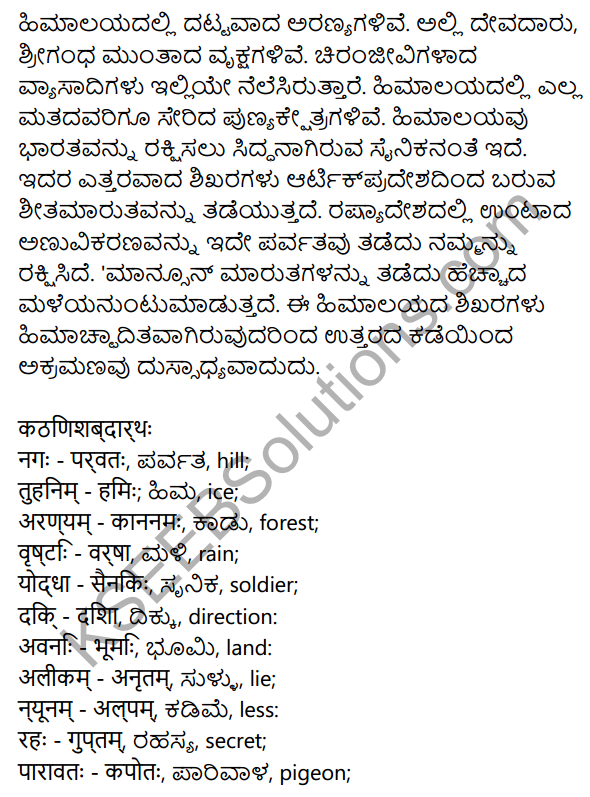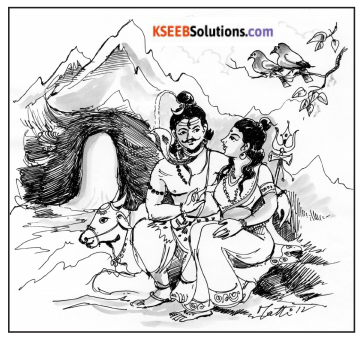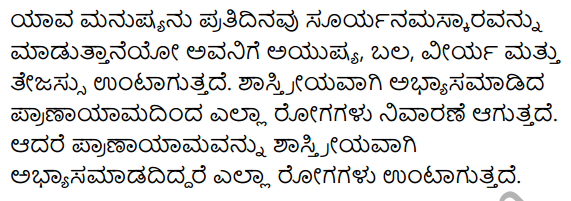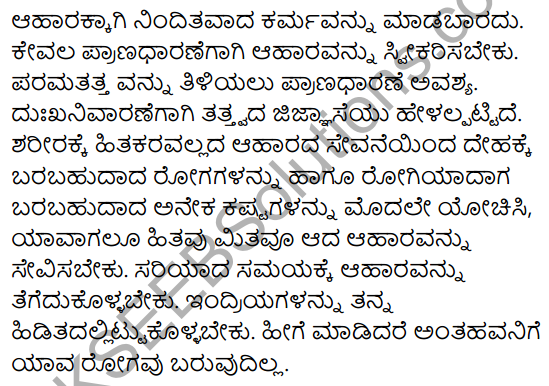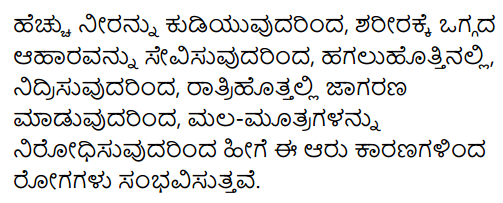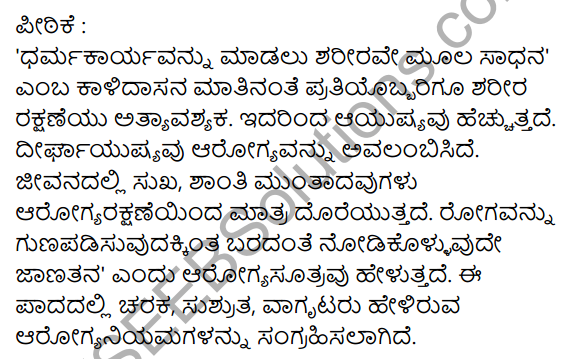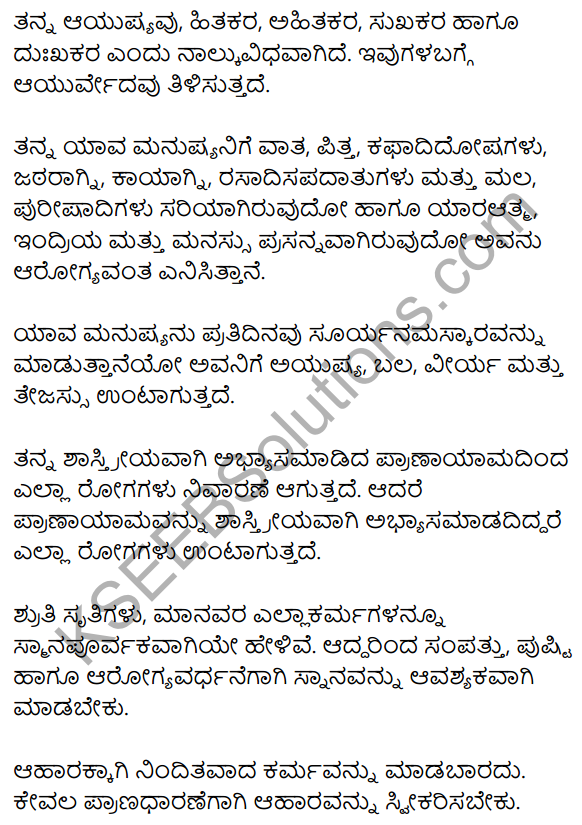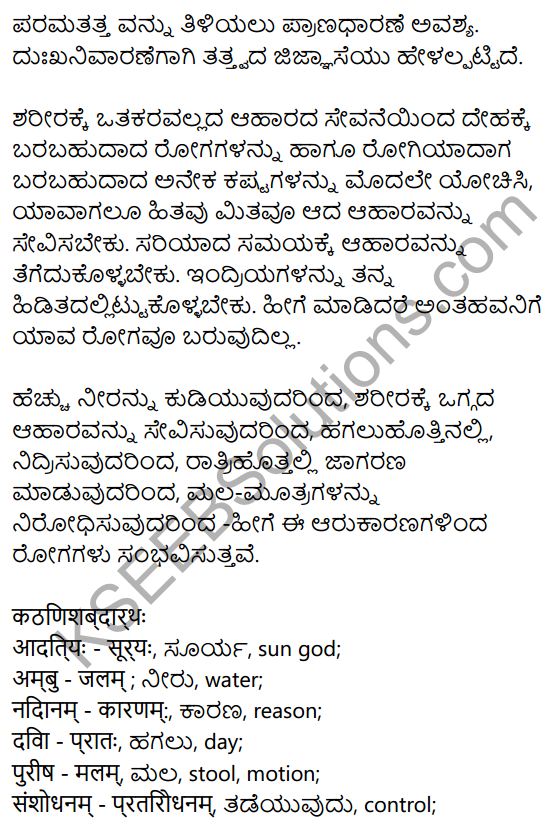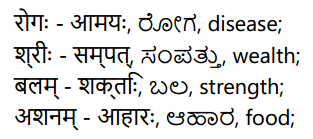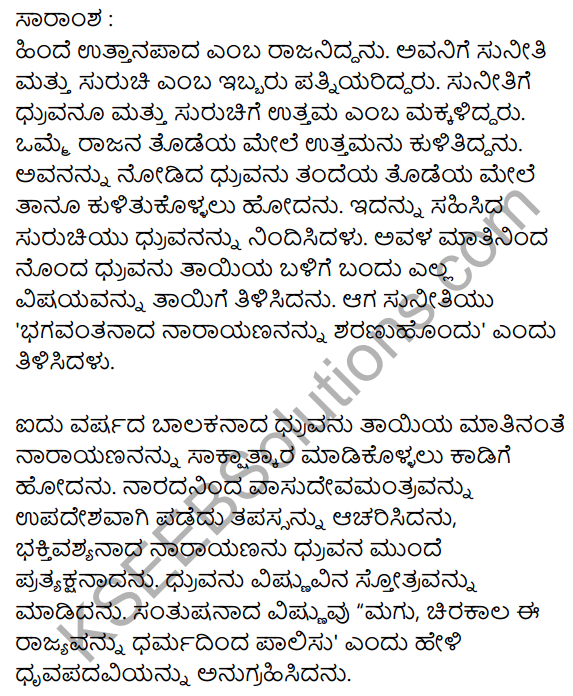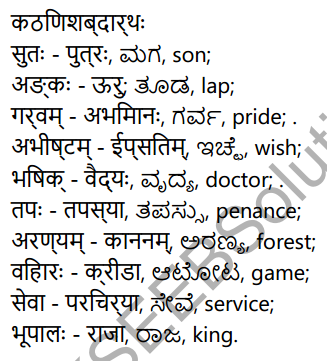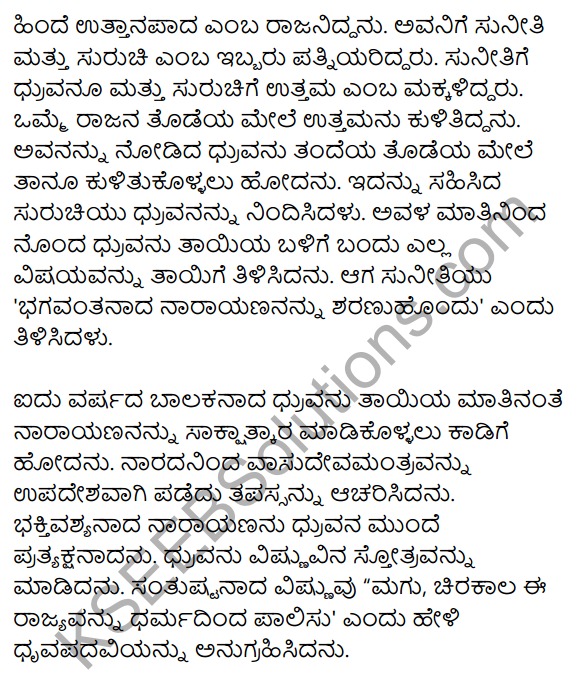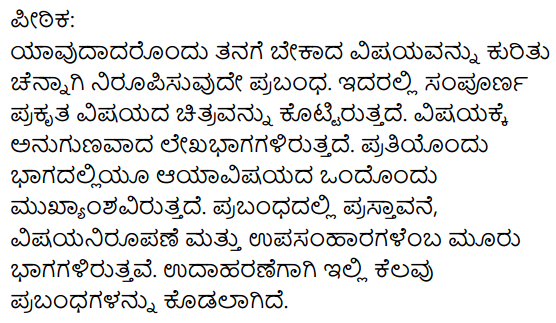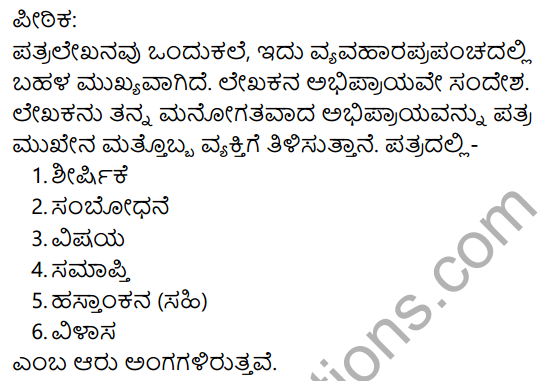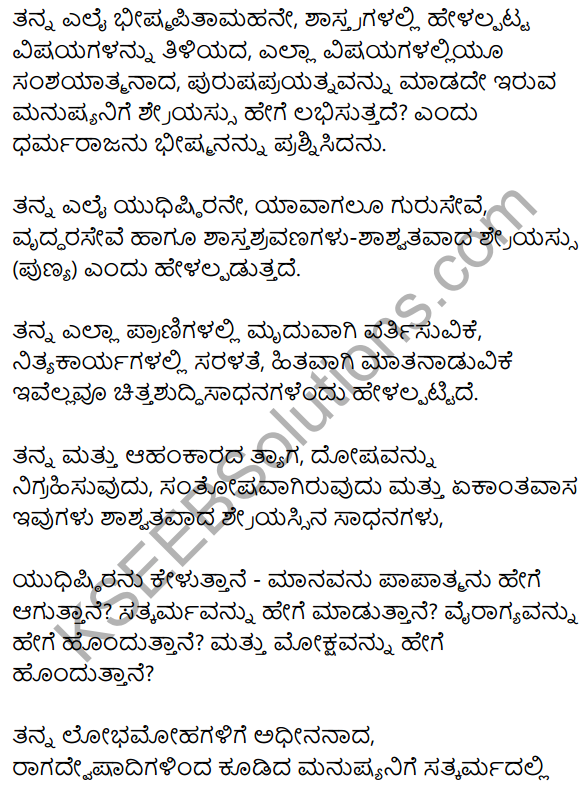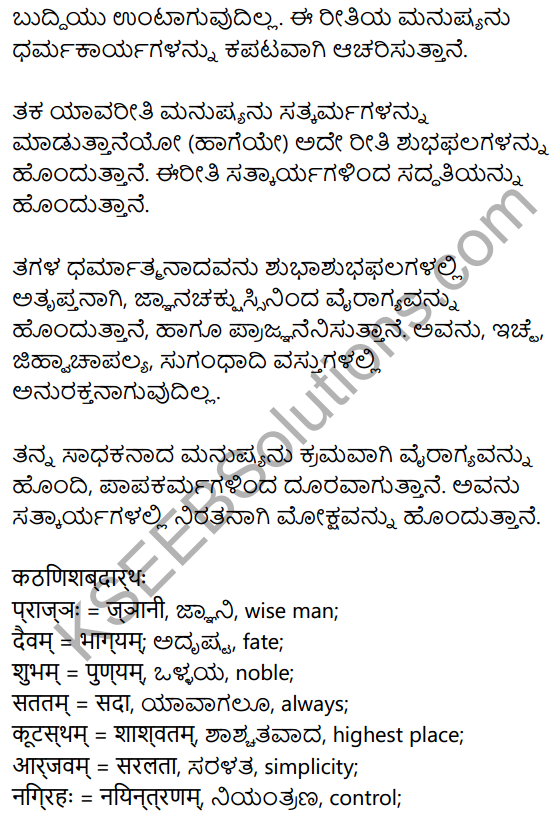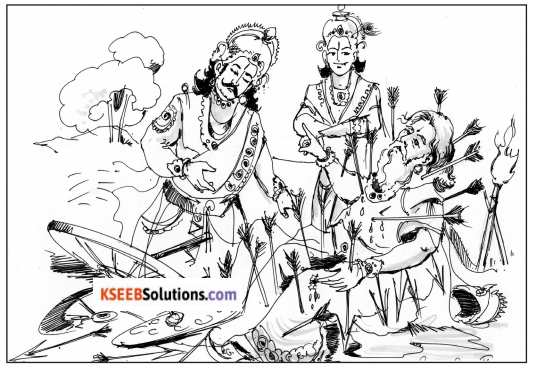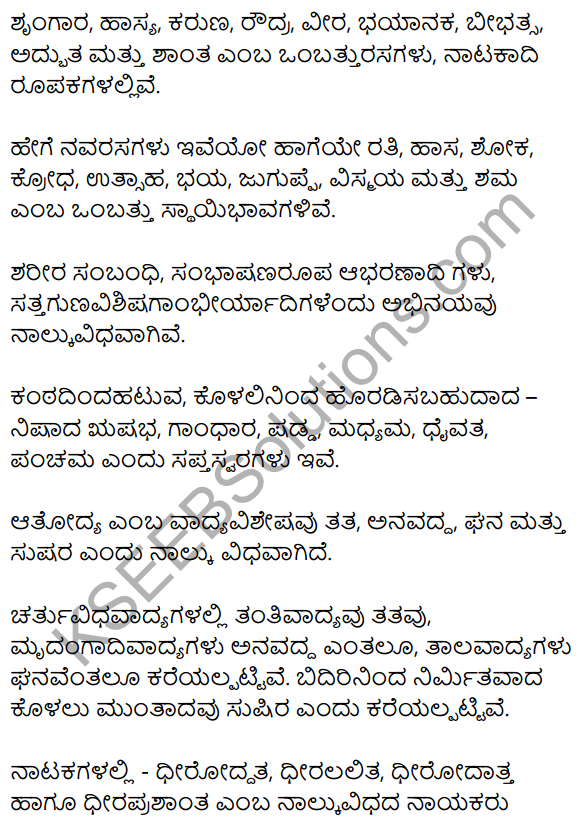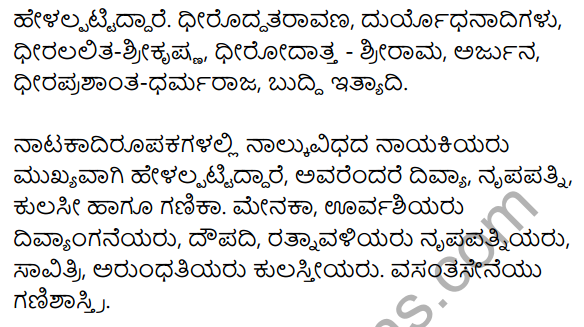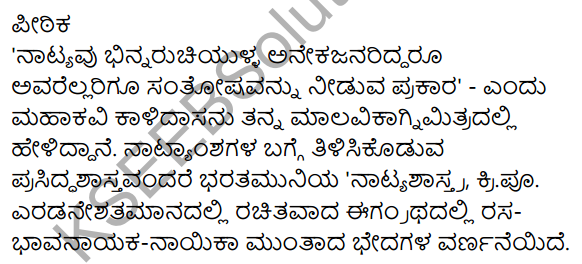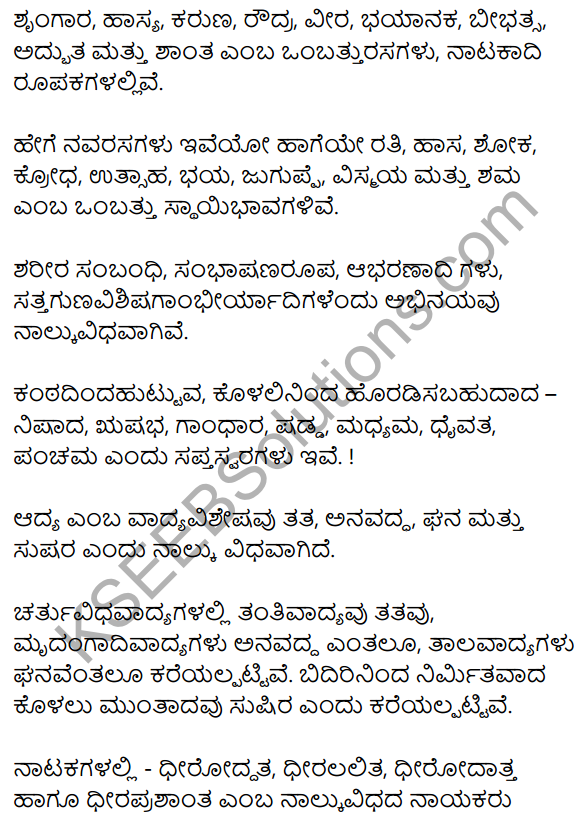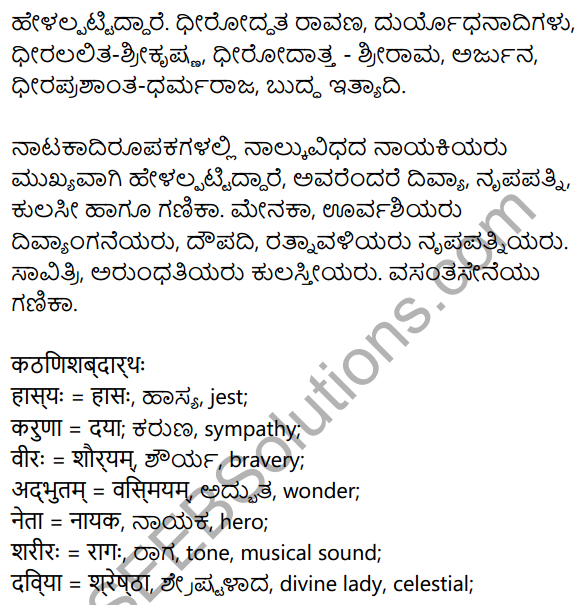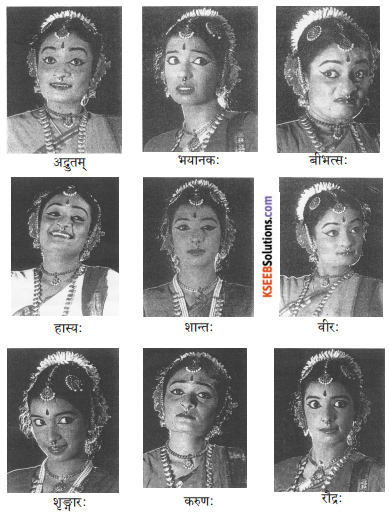Students can Download Sanskrit अपठित गद्य भागः Questions and Answers, Summary, Notes Pdf, Activity, KSEEB Solutions for Class 10 Sanskrit helps you to revise the complete Karnataka State Board Syllabus and score more marks in your examinations.
Karnataka State Syllabus Class 10 Sanskrit अपठित गद्य भागः
1. चाणक्यः मगधदेशस्य चन्द्रगुप्तमौर्यस्य मन्त्री आसीत्। सः एकस्मिन् उटजे वसति स्म। एकदा राजा दरिद्रेभ्यः दातुं कम्बलान् दत्तवान्। केचन चोराः कम्बलान् चोरयितुं चाणक्यस्य उटजम् आगताः। तदा शीतकालः आसीत् । तथापि चाणक्यः कम्बलं विना एव भूमौ सुप्तः आसीत्। आश्चर्यचकिताः चोराः चाणक्यं प्रबोधितवन्तः । ते अपृच्छन् – “अत्र तु अनेके कम्बलाः सन्ति। शैल्यमपि अस्ति। तथापि त्वं किमर्थं भूमौ कम्बलं विना शयनं करोषि’ तदा ताणक्यः अवदत्- “दरिद्रेभ्यः दातुं राजा दत्तवान्, एतान् कम्बलान् । एते मम कते न”। एतत् श्रुत्वा चोराः अपि सज्जनाः अभवन्। अन्येषां द्रव्यस्य उपयोगः अधर्मः इति चाणक्यस्य सन्देशः।
प्रश्न 1.
चाणक्यः कस्य मन्त्री ?
उत्तरम्
चाणक्यः चन्द्रगुप्तस्य मन्त्री आसीत् ।
प्रश्न 2.
राजा चाणक्याय किम् अयच्छत् ?
उत्तरम्
राजा चाणक्याय कम्बलान् अयच्छत् ।
![]()
प्रश्न 3. चोरः इत्यस्य पर्यायपदं किम् ?
उत्तरम्
चोरः इत्यस्य पर्यायपदं स्तेनः’ ।
प्रश्न 4.
राजा दरिद्रेभ्यः दातुं _____________ दत्तवान् ।
उत्तरम्
कम्बलान् ।
प्रश्न 5.
अस्य अनुच्छेदस्य कृते संस्कृते शीर्षिकामेकां लिखत ।
उत्तरम्
‘चाणक्यस्य सन्देशः’
2. अस्माकं राष्ट्रपिता गान्धिमहोदयः । ‘मोहनदासकरमचन्द गान्धी’ अस्य पूर्णनाम। अयं शान्तस्वभावः सत्यवादी च। अहिंसया सत्येन च जगत् अजयत् । अयं शुक्लसंवत्सरे भाद्रपदमासे कृष्णपक्षे एकादश्यां (2-10-1869) शनिवासरे पोर्बबन्दर नगरे जातः । अस्य पत्नी कस्तूरीभाई नाम्नी । पतिव्रता सा सर्वदा भर्तारमनुसृतवती । अस्य महत्ता प्रयत्नेन भारतदेशः स्वतन्त्रः अभवत् । अयं बहुवारम् उपवासम् अकरोत् कारागृहं च प्राविशत् । अमुं भूलोके सर्वे जानन्ति। अमु सर्वे पूजयन्ति। अयं प्रतिदिनं गीतां पठति स्म। एषः संस्कृतभाषां सम्यक् पठितवान् । भारतजनकाय तस्मै नमः।
प्रश्न 1.
गान्धीमहाभागस्य पूर्णनाम किम् ?
उत्तरम्
गान्धीमहाभागस्य पूर्णनाम ‘मोहनदास करम चन्द गान्धी’ इति ।
प्रश्न 2.
‘अहिंसा’- अस्य विरुद्धार्थकं पदम् ________ ।
उत्तरम्
‘अहिंसा’ – अस्य विरुद्धार्थकं पदम् हिंसा ।
![]()
प्रश्न 3.
‘पत्नी’- अत्र अन्यलिङ्गरूपं किम् ?
उत्तरम्
पत्नी शब्दस्य अन्यलिङ्गरूपं – पतिः ।
प्रश्न 4.
कं सर्वे पूजयन्ति ?
उत्तरम्
गान्धीमहोदयं सर्वे पूजयन्ति ।
प्रश्न 5.
‘एषः संस्कृतभाषां सम्यक् पठितवान्’ – अत्र कृदन्तपदं किम् ?
उत्तरम्
अत्र कृदन्तपदं – पठितवान् ।
3. हंसस्य वर्णः शुभ्रः । काकस्य वर्णः कृष्णः। एकदा कश्चित् काकः तडागस्य तीरं गच्छति। सः तत्र हंसं पश्यति । सः वदति-“अहो ! हंसः कीदृशः शुभ्रः अस्ति। अहम् अपि शुभ्र भवामि’। अनन्तरं सः काकः जलाशयस्य जलेन निजं शरीरं प्रक्षालयति। तदा सः पाषाणस्य खण्डेन स्वशरीरं घर्षति। वारं वारं घर्षति सः तथापि कृष्णः वर्णः शुभ्रः न भवति। घर्षणेन तस्य शरीरे तीव्रा वेदना भवति । अन्ते सः पञ्चत्वं गच्छति। अहो ! काकस्य मूर्खता।
प्रश्न 1.
‘हंसः’ अस्य अन्यलिङ्गरूपं लिखत ।
उत्तरम्
हंसशब्दस्य अन्यलिङ्गरूपं – हंसी ।
![]()
प्रश्न 2.
‘काकस्य वर्णः कृष्णः’ अत्र विशेषणपदं किम् ?
उत्तरम्
अत्र विशेषणपदं – कृष्णः ।
प्रश्न 3.
‘प्रतिवारम्’ अस्य विग्रहवाक्यं लिखत ।
उत्तरम्
वारं वारं प्रति ।
प्रश्न 4.
अन्ते काकस्य गतिः का?
उत्तरम्
अन्ते काकः पञ्चत्वं गच्छति ।
प्रश्न 5.
अस्य गद्यभागस्य नीतिः का?
उत्तरम्
गद्यभागस्य नीति ‘काकस्य मूर्खता’ ।
4. कश्चित् राजा चोरं शूलमारोपयितुम् आदिशति। ‘बुद्धिमुपयुज्य जीवामि’ इति चिन्तयन् चोरः वदति – ‘प्रभो ! अहं सुवर्णकृषि जानामि। सुवर्णबीजानि मया सह वर्तन्ते। क्षेत्राणि सज्जीकुर्वन्तु, भवन्तः एव बीजानि वपन्तु । तदनन्तरं मां शूलमारोपयन्तु । तेन जगतः कल्याणं भवतु’ इति । राजा तथैवाङ्गीकरोति । क्षेत्राणि सिद्धानि भवन्ति। यः कदापि यत्किमपि चौर्यम् नाकृतवान् तादृशः सुवर्णबीजानि वपेत् इति नियमः इति चोरः वदति। आबाल्यं स्वकीयं चौर्यं स्मरन्तः तूष्णीं भवन्ति सर्वेऽपि । तदा ‘य’ कोऽपि चोरः नास्ति चेत् अहमेव किमर्थं शूलमारोपयितव्यः ? इति सः पृच्छति। राजा लज्जया तं मोचयति ।
![]()
प्रश्न 1.
सुवर्णबीजवपनस्य नियमः कः ?
उत्तरम्
यः चौर्यं न कृतवान् तादृशः सुवर्णबीजानि वपेत् ।
प्रश्न 2.
चोरः किं चिन्तयति ?
उत्तरम्
बुद्धिम् उपयुज्य जीवामि इति चिन्तयति ।
प्रश्न 3.
अचोरः इत्यत्र समासः कः ?
उत्तरम्
न चोरः – नञ्तत्पुरुषः ।
प्रश्न 4.
वपेत् अत्र कः लकारः ?
उत्तरम् विधिलिङ्लकारः ।
प्रश्न 5.
अस्य परिच्छेदस्य उचितं नाम दीयताम् ?
उत्तरम् बुद्धिमान् चोरः ।
![]()
5. श्रीकृष्णः धर्मराजस्य वाचमङ्गीकृत्य दुर्योधनस्य समीपं सन्धानार्थं गच्छति। दुर्योधनसभां प्रविश्य अर्धराज्यं पाण्डवेभ्यः दातुं वदति। ‘राज्यं कदापि दानरूपेण नैव दीयते। तत् युद्धे विजित्य प्राप्तव्यं भवति’ इति दुर्योधनः वक्तिं । तदा श्रीकृष्णः ‘ज्ञातिनां मध्ये सङ्घर्षः नोचितः, युद्धं तु शत्रूणां मध्ये उचितम्’ इति अवगमयितुं प्रयतते। परन्तु दुर्योधनः ‘ते देवपुत्राः, वयं तु मानवाः, तदा कथं ते सम्बन्धिनः अस्माकं भवन्ति ? अहन्तु तेभ्यः वाटिकामपि नैव यच्छामि, यदि शक्तिरस्ति युद्धे अस्मान् पराजित्य राज्यं लभन्ताम्’ इति दर्पण गदति। तत् श्रुत्वा ‘विनाशकाले विपरीतबुद्धिः, अहङ्कारः न कापि हिताय।’ इति चिन्तयन् श्रीकृष्णः युद्धमेव निश्चित्य धर्मराजसमीपं व्रजते ।
प्रश्न 1.
दुर्योधनः पाण्डवैः सह तस्य सम्बन्धः नास्तीति कथं निरूपयत?
उत्तरम्
पाण्डवाः देवपुत्राः इति उक्त्वा निरूपयति ।
प्रश्न 2.
श्रीकृष्णः किमर्थं दुर्योधनसभां गच्छति?
उत्तरम्
श्रीकृष्णः सन्धानार्थं दुर्योधनसभां गच्छति ।
प्रश्न 3.
राज्यं कथं प्राप्तव्यं भवति ?
उत्तरम्
राज्यं युद्धे विजित्य प्राप्तव्यम् ।
![]()
प्रश्न 4.
विजित्य अत्र कः प्रत्ययः ?
उत्तरम्
ल्यप् प्रत्ययः ।
प्रश्न 5.
ज्ञानिपदस्य समानार्थकं पदं किम् ?
उत्तरम्
सम्बन्धिनः।
6. प्राणिनः अस्माकं मित्राणि सन्ति। मृगालये प्राणिनः अस्माकं मनांसि रञ्जयन्ति। मृगालये व्याघ्रः, जम्बूकः, सिंहः, वानरः, मकरः, शशकः, हरिणः इत्यादिमृगाः वसन्ति। सिंहः उच्चैः गर्जति। वानरः पञ्जरे भ्रमति। तस्य पुच्छः दीर्घः भवति। मकरः जले निवसति। मयूरः नृत्यति, मयूरः अस्माकं राष्ट्रपक्षी । गजः तृणम् इक्षुदण्डं च खादति। हरिणः धावति। मृगालयः मनसः सन्तोषं जनयति।
प्रश्न 1.
मृगालयः किं जनयति?
उत्तरम्
मृगालयः मनसः सन्तोषं जनयति ।
प्रश्न 2.
मकरं कुत्र वसति ?
उत्तरम्
मकरः जले वसति ।
![]()
प्रश्न 3.
मयूरः अस्माकं __________ पक्षी ।
उत्तरम्
मयूरः अस्माकं राष्ट्रपक्षी ।
प्रश्न 4.
‘लाङ्गलम्’ – अस्य पर्यायपदम् __________
उत्तरम्
पुच्छम् ।
प्रश्न 5.
भवति’ – अस्य लङ्लकाररूपम् इदम् ।
(1) अभवत्
(2) भवतु
(3) भविष्यति
(4) भवेत् ।
उत्तरम्
(1) अभवत् ।
